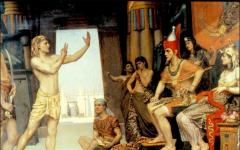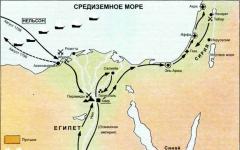Mathematics lesson on the topic "Multiplying and dividing three-digit numbers by a single-digit number without going through the place value."
Target: consolidate the knowledge, skills and abilities of multiplying and dividing a three-digit number by a single-digit number without going through a digit; develop the ability to apply theoretical knowledge and problem-solving skills in practice; develop verbal and logical thinking through formulation problematic issues, attentiveness, intelligence, independence; bring up moral qualities by organizing mutual assistance, discussing the qualities needed in the lesson. positive lesson motivation.
Equipment: computer, overhead projector, presentation, cards.
PROGRESS OF THE LESSON
Breathing exercise “New lesson”.
For an entertaining lesson
A loud bell started.
Are you ready to count?
Divide and multiply quickly.
- What qualities and learning skills will we need in the classroom? Select.
(slide No. 2)
Quick wit
Savvy
Laziness
Attention
Noise
Perseverance
- Do we take them with us to class?
II. Checking homework
Attention! Attention!
We start the lesson by checking homework.
Homework: No. 745, p. 160.
(slide No. 3)
"Find the extra number"
321, 222, 243, 212, 444, 221, 214, 211, 311, 142, 123
(slide 2)
- Who agrees with the number?
Children raise their hands.
Create an example whose answer can be 444.
What else was assigned at home?
2. Mathematical dictation.
Product of numbers 8 and 9;
quotient of 36 and 4;
increase 8 by 6 times;
reduce 27 by 3 times;
How many times is 15 greater than 3?
1 is a factor of 9, the second is the same, what is the product equal to;
dividend 42, quotient 7, what is the divisor;
What number cannot be divided by?
Now check yourself!(Slide No. 4)
b) You answer either “yes” or “no” to the following questions
All three-digit numbers are odd;
All three-digit numbers are greater than 9;
If a number is multiplied by 1, it becomes 1;
If a number is divided by itself, the result is 0;
All even numbers divisible by 2
Some three-digit numbers are less than 9;
You cannot divide by 0;
When you multiply a number by 1, you get the same number;
Test yourself!(Slide No. 4)
III. Oral counting
(slide 5)
1. One T-shirt in the store costs 80 rubles. How much money do you need to pay to buy T-shirts for all the boys in our class?(80 rub. x 8 = 640 rub.)
2. We bought skirts for the girls in our class. We paid 250 rubles for the entire purchase. How much does one skirt cost?(250r.:1=250r.)
3. The school purchased 200 packs of laundry soap. Each pack costs 5 rubles. Calculate the total purchase price.(5 rubles x 200 = 1000 rubles)
- What did we repeat when solving this problem?(We repeated the multiplication and division tables.)
IV. State the topic and purpose of the lesson.
V. Fixing the material.
a) Solving the problem using short notation
(slide No. 6)
- Think and compose a problem, starting with the words:
In a week our school spends...
- What is this task about?(This problem is about vegetables: potatoes and carrots.)
- What is known in the problem?(It is known that potatoes488 kg consumed.)
- What is said about carrots?(Carrots are consumed 4 times less than potatoes.)
- How do we find out how many carrots have been used?(Division action 488: 4 = 122 kg)
- Is it possible to answer the problem question now?(Let's add potatoes and carrots together and answer the question in the problem.)
Solving the problem on the board and in notebooks with comments
Physical exercise.
a) Game “Sharing - not sharing”
(Slide No. 7)
- I name a couple of numbers. Your task: if the numbers are divided among themselves, then you quietly get up; If they don’t share, then clap your hands.
248: 2 = ;
367: 3 = ;
848: 4 = ;
481: 2 = ;
936: 3 = ;
695: 3 = .
b) Exercise for the eyes. (Slide No. 8,9)
Watch carefully the movement of the multi-colored circles!
VI. Consolidation
a) Write down only the answers. (Slide No. 10)
Check (Slide No. 11).
b) Working with the textbook.
Page 160 No. 741 - at the blackboard.
Analysis and analysis of the problem.
c) Independent work
223
450
101
777
684
969
Peer review.
VII. Homework. (slide No. 12)
- At home you should solve No. 747p. 160.
(Analysis of d/z).
VII. Lesson summary. Grading.
Reflection (Today in class I….).
Zaostrovye
2014
Annotation
Lesson summary accompanied by a presentation on the topic Multiplication and division of three-digit numbers (Lesson of transferring existing knowledge to a new number concentration) for grade 3 in the school 2100 system. Entertaining selection of material, various forms works increase students' interest in the material being studied. The lesson was developed within the framework of the Federal State Educational Standard.
Equipment: presentation, cards with examples A and B for multiplying and dividing three-digit numbers, test on the card, textbook, (part 2).
Lesson 87 (§ 2.32).
Subject: Multiplying and dividing three-digit numbers (Lesson of transferring existing knowledge to a new number concentration)
Goals: introduce algorithms for oral techniques for multiplying and dividing three-digit numbers, similar to the same techniques for multiplying and dividing double digit numbers
Tasks:
Educational:
Get acquainted with algorithms for oral techniques for multiplying and dividing three-digit numbers, similar to the same techniques for multiplying and dividing two-digit numbers.
Solve text problems of the studied type using a new numerical concentration.
Solve inequalities by selecting variable values.
Systematically repeat and consolidate what you have previously learned.
Educational: develop mental counting skills, improve mental operations, ability to argue your opinion, mathematical abilities.
Educational: cultivate interest in the subject, curiosity, independence, accuracy, and the ability to listen to the teacher and his friends.
Form UUD:
Personal UUD: Independently determine and express the simplest rules of behavior common to all people in communication and cooperation. In independently created situations of communication and cooperation, based on simple rules of behavior common to everyone, make a choice about what action to take.
Regulatory learning activities: independently formulate lesson goals after preliminary discussion. Learn together with the teacher to discover and formulate educational problem. Make a plan to solve the problem together with the teacher. Working according to the plan, check your actions with the goal and, if necessary, correct mistakes with the help of the teacher. In dialogue with the teacher, learn to develop evaluation criteria and determine the degree of success in performing your own work and the work of everyone, based on the existing criteria.
Communicative UUD: Convey your position to others: express your point of view and try to substantiate it by giving arguments. Listen to others, try to accept another point of view, be willing to change your point of view.
Cognitive UUD: Independently assume what information is needed to solve a learning task. Solve problems by analogy.
Symbols:
Lesson type: introducing new knowledge
Teaching methods: visual, verbal, problem-search.
– What did you have to do in the task?
– Did you manage to solve the assigned tasks correctly?
– Did you do everything right or were there mistakes or shortcomings?
– Did you decide everything yourself or with someone’s help?
What level of difficulty was the task?
Do the guys have any additions or comments? Do you agree with this self-assessment?
Conclusion? Students: consolidated the ability to solve a text problem, in which they repeated multiplication and division, the order of actions, learned to compose and solve expressions, etc.
Test.
Well done! Here we end our journey. To get us back, try solving the test in groups. If you do it correctly, you should have a word. But first, let's remember the rules for working in groups. Do it.
1. How can you represent it as a product of two
multipliers number 24?
a) 8 * 2 b) 7 * 3 m) 8 * 3 d) 3 * 6
2.What number is divisible by 6?
a) 46 o) 42 c) 28
3.What number needs to be substituted for equality to be
63 * = 9 l) 7 b) 6 c) 8
4. What numbers have the quotient equal to 4?
a) 36 and 6 o) 24 and 6 c) 2 and 2
5. Find the numbers whose product is equal to 12?
a) 6 and 3 b) 2 and 7 c) 3 and 5 d) 6 and 2 f) 4 and 3
6. How much should you divide 48 to get 6?
c) by 8 b) by 7 c) by 6
7. There were 18 books on the top shelf, and on the bottom - 3 times less than on the top. How many books were on the bottom shelf?
a) 9 books b) 6 books c) 3 books
4 – working according to plan, check
their actions with the aim and, if necessary, to correct errors with the help of the class;
5 – in dialogue with the teacher and other students, learn to develop evaluation criteria and determine the degree of success in performing their own work and the work of everyone, based on the existing criteria.
Communicative UUD
We develop skills:
1.- convey your position to others: formalize your thoughts verbally and writing(expression of the solution to an educational problem in generally accepted forms) taking into account one’s own educational speech situations;
TOUU
2 – convey your position to others: express your point of view and try to justify it by giving arguments;
3 – listen to others, try to accept a different point of view, be ready to change
questions to the text and look for answers; check yourself;
separate the new from the known;
highlight the main thing; make a plan;
5 – negotiate with people: fulfilling various roles in a group, cooperate in jointly solving a problem (task).
Personal results:
1 – adhere to ethical standards of communication and cooperation when working together on a learning task;
Target audience: for 3rd grade.
Summary of an open lesson in 3rd grade.
Volkova Lyubov Andreevna, primary school teacher.
Lesson type: combined.
Target: - consolidate the ability to divide and multiply three-digit numbers by a single-digit number;
Develop the ability to perform calculations of the form 800: 200; 630:90 (dividing three-digit numbers into round three-digit and two-digit numbers);
Tasks:
Continue to develop mental counting skills;
Improve the ability to solve problems and examples;
Develop mental processes - memory, thinking, attention;
To foster communicative relationships between students and a sense of teamwork;
Cultivate interest in the subject;
Cultivate a child’s interest in the subject and knowledge of the world.
Equipment: textbook, workbook, colored task cards for differentiated work, computer, presentation, poster (digits of three-digit numbers), picture of a cat.
Progress of the lesson.
Organizational moment.
(slide 1)
There are many interesting things in life,
But so far unknown to us,
And learn a lot.
Teacher: Guys, I see that you are all ready for the lesson. Sit down. We continue to study three-digit numbers and practice multiplying and dividing them. Today's lesson will begin in an unusual way. Listen to the melody from a well-known cartoon.
An excerpt from the song “There is nothing better in the world…” is played (30 sec., slide 1)
Teacher: Do you recognize the melody? From what cartoon?
Children: Bremen Town Musicians.
Teacher: That's right! Today in the lesson we will solve problems and find the meaning of expressions together with the troubadour and the Bremen musicians.
(slide 2)
Oral counting.
a) And here is the first task!(slide 3) The Bremen musicians staged a performance in the city square. The first number with the sign is 75:15. Who's speaking next?
Children find the meaning of expressions by reasoning out loud. The answer to the previous example serves as the beginning of each next one.
b)slide 4
Teacher: Let's imagine that the Cat from the Bremen Town Musicians decided to show tricks with three-digit numbers. I will ask a question, and you will name a number.(The work is carried out on a chalkboard, under a table with the ranks of three-digit numbers and a picture of a cat).
Now a number will appear in which there are 5 hundreds, 6 tens and 2 ones.
…… 30 tens.
… 4 hundreds.
The number that more number 289 to 1
A number that is less than 658 by 1.
Fizminutka (game “attention”)
Updating knowledge. Statement of a problematic question.
Teacher: Let's check how we learned to multiply and divide three-digit numbers. The Rooster prepared examples.(Slide 5)
Look, have we already solved all kinds of examples? The Rooster hid examples here with solutions that we have not yet met.
Teacher: Let's reason and find a solution to the problem.
We open the notebooks, write down the number, cool work, No. 1
Discovery of new knowledge.
One student decides at the board, the rest of the students do the work in their notebooks. When we reach the fourth column, we display a “new” technique for dividing a three-digit number. We divide a three-digit number into round two-digit and three-digit numbers, reasoning as follows (by analogy with dividing round two-digit numbers):
800: 200 = 4, since 4* 200 = 800 (slide 6)
We confirm the validity of our conclusion with the rule in the textbook on page 55
Consolidation
Textbook assignments p. 56 No. 5 (1, 2 columns)
One student works at the board, reasoning out loud, the rest in their notebooks.
Problem No. 8 p. 56
The teacher, together with the children, makes a short note on the board and analyzes the stages of solving the problem. One student solves the problem from the back of the board. At the end there is a check: students compare their notes with the notes on the board. Compare the answer with the answer on the slide(slide 8)
Exercise (exercise for the eyes)
Working with cards.
Solving problems of two levels of complexity. For successful students, the text of the problem coincides with the text of problem No. 9 from the textbook.
Card level 1 (green card)
Bremen musicians gave a concert for city residents. The audience heard 27 songs, which is 8 less than dance tunes. How many pieces of music were performed in the concert?
Card level 2 (red card)
Bremen musicians gave a concert for city residents. The audience heard 27 songs, which is 8 less than dance tunes. These musical works were performed in two parts of the concert, equally divided in each part. How many pieces of music were performed in each department?
Compilation of a short note for both tasks is discussed together with the teacher.(slide 13-14)
Independent work of the guys.
Lesson summary.
Teacher: Every lesson we try to learn more than we knew. Let's go up a step. What new have we learned today?
(Learned to divide three-digit numbers into round two-digit and three-digit numbers)
Homework.
The task is offered to the children at different levels. Written with multi-colored chalk on a blackboard.
In green (for everyone): p. 56 No. 5 (3.4 columns), No. 7.
With red chalk (for those who want something more complicated): p.56 No. 6, No. 10.
Additional task (if there is time left)
Slide 15
Write down the names of all polygons containing angle ABC (No. 11 p. 56)
Slide 16 Well done!
Municipal state educational institution Lyceum No. 7
Summary of an open mathematics lesson.
Multiplying and dividing three-digit numbers by single-digit numbers.
Primary school teacher
Volkova Lyubov Andreevna
Solnechnogorsk
2013
At school these actions are studied from simple to complex. Therefore, it is imperative to thoroughly understand the algorithm for performing these operations on simple examples. So that later there will be no difficulties with dividing decimal fractions into a column. After all, this is the most difficult version of such tasks.
This subject requires consistent study. Gaps in knowledge are unacceptable here. Every student should learn this principle already in the first grade. Therefore, if you miss several lessons in a row, you will have to master the material yourself. Otherwise, later problems will arise not only with mathematics, but also with other subjects related to it.
The second prerequisite for successfully studying mathematics is to move on to examples of long division only after addition, subtraction and multiplication have been mastered.
It will be difficult for a child to divide if he has not learned the multiplication table. By the way, it is better to teach it using the Pythagorean table. There is nothing superfluous, and multiplication is easier to learn in this case.
How are natural numbers multiplied in a column?
If there is difficulty in solving examples in a column for division and multiplication, then you should begin to solve the problem with multiplication. Since division is the inverse operation of multiplication:
- Before multiplying two numbers, you need to look at them carefully. Choose the one with more digits (longer) and write it down first. Place the second one under it. Moreover, the numbers of the corresponding category must be under the same category. That is, the rightmost digit of the first number should be above the rightmost digit of the second.
- Multiply the rightmost digit of the bottom number by each digit of the top number, starting from the right. Write the answer below the line so that its last digit is under the one you multiplied by.
- Repeat the same with another digit of the lower number. But the result of multiplication must be shifted one digit to the left. In this case, its last digit will be under the one by which it was multiplied.
Continue this multiplication in a column until the numbers in the second factor run out. Now they need to be folded. This will be the answer you are looking for.

Algorithm for multiplying decimals
First, you need to imagine that the given fractions are not decimals, but natural ones. That is, remove the commas from them and then proceed as described in the previous case.
The difference begins when the answer is written down. At this moment, it is necessary to count all the numbers that appear after the decimal points in both fractions. This is exactly how many of them need to be counted from the end of the answer and put a comma there.
It is convenient to illustrate this algorithm using an example: 0.25 x 0.33:

Where to start learning division?
Before solving long division examples, you need to remember the names of the numbers that appear in the long division example. The first of them (the one that is divided) is divisible. The second (divided by) is the divisor. The answer is private.
After that, in simple everyday example Let us explain the essence of this mathematical operation. For example, if you take 10 sweets, then it’s easy to divide them equally between mom and dad. But what if you need to give them to your parents and brother?
After this, you can become familiar with the division rules and master them using specific examples. First simple ones, and then move on to more and more complex ones.
Algorithm for dividing numbers into a column

First, let us present the procedure for natural numbers divisible by a single-digit number. They will also be the basis for multi-digit divisors or decimal fractions. Only then should you make small changes, but more on that later:
- Before doing long division, you need to figure out where the dividend and divisor are.
- Write down the dividend. To the right of it is the divider.
- Draw a corner on the left and bottom near the last corner.
- Determine the incomplete dividend, that is, the number that will be minimal for division. Usually it consists of one digit, maximum of two.
- Choose the number that will be written first in the answer. It should be the number of times the divisor fits into the dividend.
- Write down the result of multiplying this number by the divisor.
- Write it under the incomplete dividend. Perform subtraction.
- Add to the remainder the first digit after the part that has already been divided.
- Choose the number for the answer again.
- Repeat multiplication and subtraction. If the remainder is zero and the dividend is over, then the example is done. Otherwise, repeat the steps: remove the number, pick up the number, multiply, subtract.
How to solve long division if the divisor has more than one digit?
The algorithm itself completely coincides with what was described above. The difference will be the number of digits in the incomplete dividend. Now there should be at least two of them, but if they turn out to be less than the divisor, then you have to work with the first three digits.
There is one more nuance in this division. The fact is that the remainder and the number added to it are sometimes not divisible by the divisor. Then you have to add another number in order. But the answer must be zero. If you are dividing three-digit numbers into a column, you may need to remove more than two digits. Then a rule is introduced: there should be one less zero in the answer than the number of digits removed.
You can consider this division using the example - 12082: 863.
- The incomplete dividend in it turns out to be the number 1208. The number 863 is placed in it only once. Therefore, the answer is supposed to be 1, and under 1208 write 863.
- After subtraction, the remainder is 345.
- You need to add the number 2 to it.
- The number 3452 contains 863 four times.
- Four must be written down as an answer. Moreover, when multiplied by 4, this is exactly the number obtained.
- The remainder after subtraction is zero. That is, the division is completed.
The answer in the example would be the number 14.
What if the dividend ends in zero?
Or a few zeros? In this case, the remainder is zero, but the dividend still contains zeros. There is no need to despair, everything is simpler than it might seem. It is enough to simply add to the answer all the zeros that remain undivided.
For example, you need to divide 400 by 5. The incomplete dividend is 40. Five fits into it 8 times. This means that the answer should be written as 8. When subtracting, there is no remainder left. That is, the division is completed, but a zero remains in the dividend. It will have to be added to the answer. Thus, dividing 400 by 5 equals 80.

What to do if you need to divide a decimal fraction?
Again, this number looks like a natural number, if not for the comma separating the whole part from the fractional part. This suggests that the division of decimal fractions into a column is similar to that described above.
The only difference will be the semicolon. It is supposed to be put in the answer as soon as the first digit from the fractional part is removed. Another way to say this is this: if you have finished dividing the whole part, put a comma and continue the solution further.
When solving examples of long division with decimal fractions, you need to remember that any number of zeros can be added to the part after the decimal point. Sometimes this is necessary in order to complete the numbers.

Dividing two decimals
It may seem complicated. But only at the beginning. After all, how to perform division in a column of fractions by natural number, it’s already clear. This means that we need to reduce this example to an already familiar form.
It's easy to do. You need to multiply both fractions by 10, 100, 1,000 or 10,000, and maybe by a million if the problem requires it. The multiplier is supposed to be chosen based on how many zeros are in the decimal part of the divisor. That is, the result will be that you will have to divide the fraction by a natural number.
And this will be the worst case scenario. After all, it may happen that the dividend from this operation becomes an integer. Then the solution to the example with division into a column of fractions will be reduced to the simplest option: operations with natural numbers.
As an example: divide 28.4 by 3.2:
- They must first be multiplied by 10, since the second number has only one digit after the decimal point. Multiplying will give 284 and 32.
- They are supposed to be separated. Moreover, the whole number is 284 by 32.
- The first number chosen for the answer is 8. Multiplying it gives 256. The remainder is 28.
- The division of the whole part has ended, and a comma is required in the answer.
- Remove to remainder 0.
- Take 8 again.
- Remainder: 24. Add another 0 to it.
- Now you need to take 7.
- The result of multiplication is 224, the remainder is 16.
- Take down another 0. Take 5 each and you get exactly 160. The remainder is 0.
The division is complete. The result of example 28.4:3.2 is 8.875.
What if the divisor is 10, 100, 0.1, or 0.01?

Just like with multiplication, long division is not needed here. It is enough to simply move the comma in the desired direction for a certain number of digits. Moreover, using this principle, you can solve examples with both integers and decimal fractions.
So, if you need to divide by 10, 100 or 1,000, then the decimal point is moved to the left by the same number of digits as there are zeros in the divisor. That is, when a number is divisible by 100, the decimal point must move to the left by two digits. If the dividend is a natural number, then it is assumed that the comma is at the end.
This action gives the same result as if the number were to be multiplied by 0.1, 0.01 or 0.001. In these examples, the comma is also moved to the left by a number of digits equal to the length of the fractional part.
When dividing by 0.1 (etc.) or multiplying by 10 (etc.), the decimal point should move to the right by one digit (or two, three, depending on the number of zeros or the length of the fractional part).
It is worth noting that the number of digits given in the dividend may not be sufficient. Then the missing zeros can be added to the left (in the whole part) or to the right (after the decimal point).

Division of periodic fractions
In this case, it will not be possible to obtain an accurate answer when dividing into a column. How to solve an example if you encounter a fraction with a period? Here we need to move on to ordinary fractions. And then divide them according to the previously learned rules.
For example, you need to divide 0.(3) by 0.6. The first fraction is periodic. It converts to the fraction 3/9, which when reduced gives 1/3. The second fraction is the final decimal. It’s even easier to write it down as usual: 6/10, which is equal to 3/5. The rule for dividing ordinary fractions prescribes replacing division with multiplication and divisor - reciprocal number. That is, the example comes down to multiplying 1/3 by 5/3. The answer will be 5/9.
If the example contains different fractions...
Then several solutions are possible. Firstly, common fraction You can try to convert it to decimal. Then divide two decimals using the above algorithm.
Secondly, every finite decimal can be written in ordinary form. But this is not always convenient. Most often, such fractions turn out to be huge. And the answers are cumbersome. Therefore, the first approach is considered more preferable.
Summary of a mathematics lesson in 3rd grade. Program "School 2100".
Technology "Problematic dialogue"
Topic: Multiplication and division of round three-digit numbers (a lesson in transferring existing knowledge to a new number center).
Goal: to discover a method of oral techniques for multiplying and dividing round three-digit numbers, similar to the same techniques for multiplying and dividing two-digit numbers.
Tasks:
repeat oral techniques for multiplying and dividing two-digit numbers;
create an algorithm for oral techniques for multiplying and dividing round three-digit numbers, similar to the same techniques for multiplying and dividing two-digit numbers;
solve text problems of the studied type at the new numerical concentration;
Lesson progress:
Org moment.
Before lesson start,
I want to wish you:
Be attentive in your studies
And learn with passion.
A situation of success. Updating knowledge.
Mathematical dictation.
Where does a math lesson usually start?
Why do we write mathematical dictations?
Let's practice some calculations.
Find a number that is 3 times greater than 20.
Find a number that is 6 times less than 78.
Find the product of 23 and 4.
Find the quotient of 90 and 5.
Examination.
Write down all three-digit numbers that can be made from the numbers 2,6,0.
Tell me how many tens there are in these numbers. How many hundreds are there in these numbers?
Examination. Self-assessment of work by students.
Gap situation. Introduction to the topic of the lesson.
Here's our next task. What do you think is the purpose of the assignment?
There are 2 columns of examples on the board. The first option solves the examplesIcolumn, second option - examplesIIcolumn. (Examples are solved for a while).
16*6 840:4
84:7 130*5
13*5 360:6
72:4 840:7
84:4 160*6
36:6 720:4
Let's check.
Which option completed the task better, faster?
Why? How are the example columns different? (INIcolumn examples on multiplication and division of two-digit numbers by single-digit numbers).
Are we good at this?
How are the examples different?IIcolumn? (More difficult. Here are examples of multiplying and dividing three-digit numbers by single-digit numbers).
We can do this, do we know? What can't we do? (We don’t know how to multiply and divide three-digit numbers).
How are all three-digit numbers in column 2 similar? (they end with 0, round)
Setting the lesson goal.
What is the purpose of our lesson today? (Learn to multiply and divide round three-digit numbers by single-digit numbers). What is the topic of the lesson?
Physical education minute.
Discovery of new knowledge. (Group work)
I think that you can handle this task yourself. Today I will give you different examples. Try to discover for yourself how to multiply and divide three-digit numbers by one-digit numbers.
Children work in a group.
Examples: 1st row – 840:40 2nd row – 130*5 3rd row – 400*2
Selecting the required method of action.
The groups put their decisions on the board. Solutions are compared. A more rational solution is chosen.
Question for row 3:
Is it possible to divide 400 by 2 using the same method?
Formulation of the rule.
How can you multiply or divide round three-digit numbers by single-digit numbers? (Three-digit numbers can be expressed in tens and hundreds and perform multiplication and division as two-digit numbers; turn into easier examples within 100 by expressing three-digit numbers in tens and hundreds)
Compare your conclusions with the conclusions given in the textbook on p. 74.
Does our conclusion match the conclusions given in the textbook?
Guys, have we achieved the goal of the lesson?
DID YOU UNDERSTAND A NEW TOPIC? (Self-assessment of understanding of the topic - in the margins of the notebook, the guys draw a self-assessment (self-assessment technique - emoticon)
Application of new knowledge.
Explanation of the solution to examples No. 4 on p. 74 of the textbook.
Solving problems No. 2,3 on p. 74 of the textbook.
Consolidation of what has been learned.
Solving problems No. 6 on p. 75 of the textbook. (Solution on a new numerical concentration of text problems of the studied type).
Lesson summary:
Summary:
What was the topic of the lesson? What was our goal? What is the method for multiplying and dividing round three-digit numbers? (Convert them to tens and hundreds and perform multiplication and division as with two-digit numbers).
2) Reflection:
What did you like most about the lesson? What was difficult? Do you understand the topic of the lesson? Evaluate your work in class.
3) Homework: No. 5,7 on p. 29 of the textbook.








